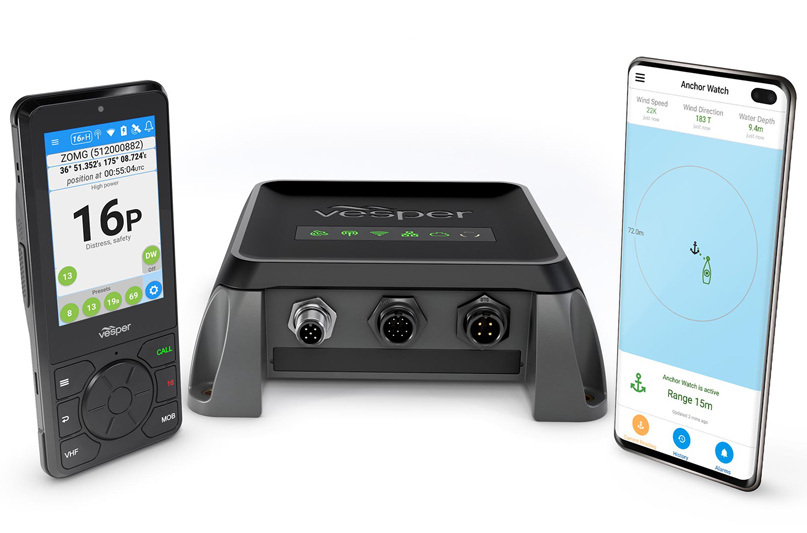Vesper Marine recently announced a brand-new concept in VHF radio communication at the National Marine Electronics Association (NMEA) Conference. The Vesper Cortex M1 is the first VHF radio monitor with wireless touchscreen handsets, built-in Class B smartAIS transponder, and remote vessel monitoring. It is a modular system—the base unit provides AIS and boat monitoring capabilities—but you can add an wired handset or portable handset with a rechargeable battery to enable VHF audio functionality along with the Cortex App for remote monitoring.
The first unique detail about the Cortex is the transponder technology. On the water, there are basically two methods to transmit AIS information: SOTDMA and CSTDMA. Carrier Sense Time-Division Multiple Access (CSTDMA) is primarily used for pleasure boating (Class B). This 2-watt transmission method uses carrier-sensing to defer transmission until no other stations are transmitting. If a free slot is found, the transmission begins and then the transmission is stopped for a 30-second interval before the next one starts. There is no sending/receiving of text messages and it takes third priority to Class A devices.
With Self-Organized Time-Division Multiple Access (SOTDMA) 5-watt technology, only the first free slot for transmission needs to be found, then the next five slots are reserved automatically, and the transmission intervals are up to every 15 seconds. You can send/receive text messages, address marine numerical identity, and it takes second priority to Class A devices. This technology was only available to commercial vessels (Class A) but is now authorized for Class B pleasure boating.

Also referred to as Class B SOTDMA or Class B 5W, this technology bridges the gap between Class A and Class B transponders. The big advantage is for faster moving boats. Not only do you have priority in time slots, even in busy AIS waters, but as your boat speed increases, the number of transmissions increase. This allows other boaters a clearer and more up-to-date view of your boat. Not only that, the built-in heading sensor tells other boats the direction you are travelling, beyond course on ground. Combining GPS, AIS, and heading data proactively warns you of collision risks.
Newer VHF radios now combine Digital Selective Calling (DSC) with a Maritime Mobile Service Identity (MMSI) number, which automatically gives your location along with a description of your boat to emergency services with the press of a button. By clearly displaying all this data on the Cortex touchscreen handset, typically complicated VHF functions become easy to use. The company explains that by touching the vessel onscreen and pressing call, you can make a direct DSC call. You then can directly contact another DSC-equipped vessel without knowing the vessel name or identity number of that vessel. Once the other vessel has confirmed, both parties are switched to a working voice channel.
VHF radio equipment has not evolved as quickly as multi-function display equipment. The introduction of DSC allowed boaters to combine VHF radio communications with a physical position. This is a game changer, especially in an emergency. With the press of a single button, responders can identify your latitude and longitude. The Vesper Cortex is taking this technology to “focus on what people use and need most” and are calling it “the VHF re-imagined.”
Other features of the Vesper Cortex include click wheel and dedicated buttons for one-handed access to critical VHF functions, wet- and glove-capable multi-touch screen, and fully waterproof, scratch-resistant glass screen. You can add up to 10 wireless handsets for bridge-to-bridge communication. The main module has a built-in VHF splitter, heading sensor, and NMEA 2000 connectivity. You can even remotely monitor your boat, receive alerts, and control onboard devices from your smartphone using the Cortex App. The basic, free subscription includes twice daily updates. A paid subscription provides increased monitoring options and is $10 per month (paid annually) or $20 monthly (cancel at any time).
Our company has been installing the Vesper WatchMate XB-8000 smartAIS Transponder for a number of years now with great success. If the Cortex follows suit, then this technology will be a home run for recreational boaters. The suggested retail for the monitor and one handset is $1,799 and it will be available through approved marine dealers in late 2019.


